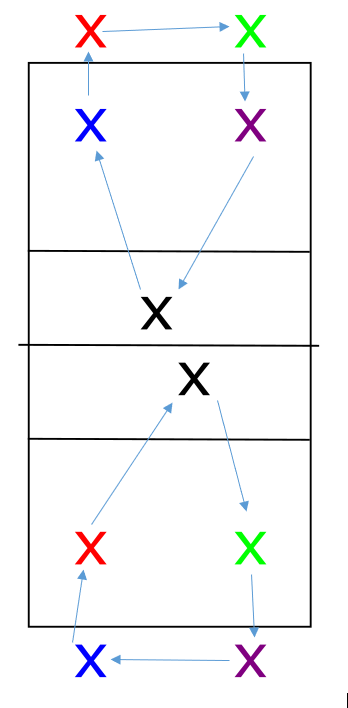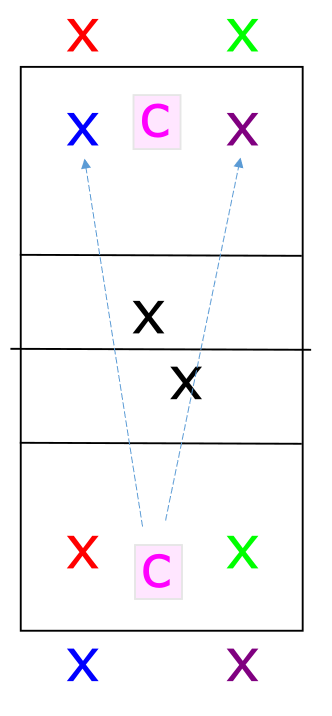4-Ball Passing
Yesterday we talked about a team profile of Terminal Serving Weakness. Sometimes teams lose Terminal Serves because they aren’t aggressive enough and they don’t produce aces. But most often teams lose Terminal Serves because they miss too many serves and they get aced too much. If I’m coaching this team, the first thing I want to do is gain some control in these areas. Can we hit a clean serve straight-on from Zone 1 to Zone 5 or from Zone 5 to Zone 1? (I don’t love serving from or to zone 6 unless there’s a specific reason.) And my passers are going to get aced sometimes as they learn to track the ball and handle tough serves, but do we have clean passing mechanics where we’re not shanking medium serves?
Hitting The Serve Straight-On
A lot of servers struggle to hit their third of the court. Even servers at high levels miss their targets. In the 2021 NCAA tournament, liberos took 1-out-of-4 of receptions and 1-out-of-3 of receptions were in Zone 61.
Some of that may have been deliberate, but it’s unlikely that such a high proportion of those serves were intended to serve a libero and/or intended to be served into Zone 6. Liberos tend to be the best passers on a team and Zone 6 tends to be the easiest zone to pass from. So let’s limit serves into that area!
There’s a lot to be said for crosscourt serving. John Kessel is a fan. Crosscourt serves with a lot of pace that end up in a seam (particularly going from 5-to-5) can be hard to deal with. But it can be harder to be accurate on those serves and servers tend to make more errors hitting the serve crosscourt. So the first thing I want to do when fixing a Terminal Serve weakness is see how well we can hit a serve straight-on into a targeted zone. In particular, can we hit it from Zone 1 to Zone 5 and from Zone 5 to Zone 1? And if we can’t, we need to start training that immediately.
Passing The Passable Balls
Some aces occur when the serve was just really tough. Serving the ball into the seams between passers is effective, as is changing depth. Most aces are in the seams between passers. But a significant amount are a shanked pass that is within the range of a specific passer.
It takes a long time to get good at tracking a good float serve. International passers work on it for years, and some never get great at it. There are always going to be wicked droppers that fall short on passers and there’s always going to be serves that catch the last few inches in the back corner. We can get our passers good on those balls, but it takes time. However, there’s a faster bang for the buck in getting passers capable and handling serves that are within their range. If we’re shanking medium serves, the other team never has to hit a great serve!
4-Ball Passing
The 4-ball passing drill is a setup that works on individual passing mechanics and controlled target serving. It’s most valuable for a high school or juniors club team which doesn’t have multiple courts and needs to maximize reps on one court. NCAA teams that have multiple courts in their practice gym often do formats for server or passer tutoring that spread the players out more. That’s ideal. But if you don’t have enough courts (or coaches) to spread players out in your gym, 4-ball passing gives you the ability to get a lot of valuable reps in a short period of time.
What It Looks Like
The base configuration has 10 player stations: 4 passers, 4 servers, and 2 targets. There’s also 2 coach stations in middle-back on each side. You can rotate players through in butterfly fashion:
Or have players stay for a set amount of time before they rotate. I prefer this because it allows the player to get a few reps in a row of each skill with an opportunity to respond to feedback. 2-minute rounds work well and 5 x 2-minute rounds will cycle a player through all 5 spots (serving behind z5, passing in z5, target, passing in z1, serving behind z1) in a pretty short amount of time. You can extend to 3 or 4 minutes per round if you want to get more extended opportunities to coach and respond to feedback.2
That setup also works well if you have additional players because you can have 1 or 2 players at each station. With 10 stations, you can actually have up to 20 players on a court and get them all a good amount of reps. It’s not ideal, but that’s the nature of coaching!
I like to position the coaches with a ball cart in middle-back on each side. Since your servers have to hit a lot of controlled serves in a short period of time, they are going to miss some serves. And if you are doing this drill specifically BECAUSE you have been missing a lot of serves, that will be especially true!3 So in that case, I have the coaches there to enter a replacement serve to either of the two passers across the net in the event of a missed serve.
When players have experience with drills like this, they get used to seeing the missed serve and immediately looking up at the coach for the replacement. This helps increase the amount of reps players get while keeping the pace high.
An extension to this is to do a “1 + 1 rep.” In this case, the player is always going to get a rep from the coach. The coach can either go before or after the server, I prefer after. So the player (hopefully) gets a rep from her server on the other side, and then, after passing that ball, she turns to the coach and gets a rep from the coach. I like this for a few reasons:
You ensure that they are getting reps with some consistency. You don’t want a player standing there for 50 seconds because the server missed 3 in a row, which will happen in this drill sometimes.
The coach reps are generally going to be easier (if they aren’t, ease up! Or mix in some tosses) and less random. I like anything where there’s a contrast in difficulty levels.
You can use the coach reps to teach something specific. For example, you can do rounds where every coach entry is going to go to the sideline, so the player has to practice that particular angle.
You can also do this as a pairs set-up:
In this case, the “Reds” and “Greens” alternate between passing and serving in zone 5 for the whole round, then they become the targets (on both sides of the net), then they alternate between passing and serving in zone 1. This is a good setup if you are focusing more on either serving or passing but want to get the reps in the other skill. For example, if your focus is more on serving, you stand back with the server in that pairs group. You can give a cue for their serve, then after serving that player will go pass, and then come back to serve again. So you are tutoring them on their serving, while their passing is more, “independent study.”
What You Don’t Get
There’s two main drawbacks to this drill.
One: your servers aren’t going to hit their hardest, most aggressive serves. With some teams, that can be a feature, rather than a bug. If you are doing this drill because you are missing too many serves, maybe it’s a good thing that they aren’t trying to blast their serve 42mph every time. But understand that if you do ONLY this drill to work on your serving, then you are going to have a lot of serves in that aren’t very tough. There’s an inherent tension between, “serving tough,” and, “serving in,” and part of planning long-term training for your team is managing that.
Two: Your passers are only passing as individuals and not as a unit. Since a significant portion of aces and shanked passes result from poor communication between passers, this is a major downside. It may be off-set by the fact that you’re getting at least twice as many individual passing reps as other passing configurations, but again, this can’t be the only serve-pass drill you do, or you’re limiting your passers.
There’s no perfect drill, so just understand the pros and cons of 4-ball passing and use it accordingly.
Per Volleymetrics stats
In general, I find longer rounds work better with higher-skilled players. I find that younger and less-skilled players struggle to maintain focus for a 4-minute round in this drill.
Coaches, pay attention so you don’t get hit in the head by an errant serve!





I’m liking the concept here. I’m trying to understand the flow of the balls (pre-serve and past target/catch) For the first example, do have ball carts at the end lines? What does the player in the target area do with the ball after the catch? Is there another cart at the net? Thanks!
always looking for efficient serve and pass drills especially for younger inexperienced players. This one sounds good and we’ll try it at this weeks practices. Thanks!!